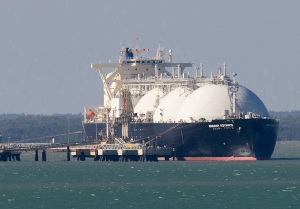
After his recent meeting with EU leaders Obama issued the incredible statement that the secret Transatlantic Trade and Investment Partnership (TTIP) that is being secretly negotiated behind closed doors by the major private multinational companies would make it easier for the United States to export gas to Europe and help it reduce its dependency on Russian energy: “Once we have a trade agreement in place, export licenses for projects for liquefied natural gas destined to Europe would be much easier, something that is obviously relevant in today’s geopolitical environment,” Obama stated.
That bit of political opportunism to try to push the stalled TTIP talks by playing on EU fears of Russian gas loss after the US-orchestrated Ukraine coup of February 22, ignores the fact that the problem in getting US shale gas to the EU does not lie in easier LNG licensing procedures in the USA and EU.
In other recent statements, referring to the recent boom in unconventional US shale gas, Obama and Kerry have both stated the US could more than replace all Russian gas to the EU, an outright lie based on physical realities. At his Brussels meeting Obama told EU leaders they should import shale gas from the US to replace Russian. There is a huge problem with that.
Shale revolution a failure
Number one, the “shale gas revolution” in the USA has failed. The dramatic rise in US natural gas production from “fracking” or forcing gas out of shale rock formations is being abandoned by the largest energy companies like Shell and BP as uneconomical. Shell has just announced a huge reduction of its exposure to US shale gas development. Shell is selling its leases on some 700,000 acres of shale gas lands in the major shale gas areas of Texas, Pennsylvania, Colorado and Kansas and says it may have to get rid of more to stop its shale gas losses. Shell’s CEO,Ben van Beurden stated, “Financial performance there is frankly not acceptable … some of our exploration bets have simply not worked out.”
A useful summary of the shale gas illusion comes from a recent analysis of the actual results of several years of shale gas extraction in the USA by veteran energy analyst David Hughes. He notes, “Shale gas production has grown explosively to account for nearly 40 percent of US natural gas production. Nevertheless, production has been on a plateau since December 2011; eighty percent of shale gas production comes from five plays, several of which are in decline. The very high decline rates of shale gas wells require continuous inputs of capital—estimated at $42 billion per year to drill more than 7,000 wells—in order to maintain production. In comparison, the value of shale gas produced in 2012 was just $32.5 billion.”
So Obama is either being lied to by his advisers on the true state of US shale gas supplies, or he is willfully lying. The former is most likely.
The second problem with the US “offer” of gas to the EU to replace Russian gas is the fact that it requires massive, costly infrastructure in the form of construction of new Liquified Natural Gas terminals that can handle the huge LNG supertankers to bring it to similar huge LNG terminal harbors in the EU.
The problem is that owing to various US laws on export of domestic energy and supply factors, there exist no operating LNG liquefaction terminals in the US. The only one now under construction is the Sabine Pass LNG receiving terminal in Cameron Parish, Louisiana, owned by Cheniere Energy, where John Deutch, former CIA head, sits on the board. The problem with the Sabine Pass LNG terminal is that most of the gas has been pre-contracted to Korean, Indian and other Asian LNG customers, not to the EU.
The second problem is that even were a huge port capacity installed to satisfy EU gas needs to replace Russian supplies, that would push domestic natural-gas prices higher and cut short the mini-manufacturing boom fueled by abundant, cheap shale gas. The ultimate cost to EU consumers of US LNG would have to be far more than current Russian gas pipelined over Nord Stream or Ukraine. The next problem is that the specialized LNG supertankers do not exist to supply the EU market. All this takes years, including environmental approvals, construction time, perhaps seven years on average in best conditions.
The EU gets some 30% of its gas, the fastest-growing energy source there, from Russia today. In 2007, Russia’s Gazprom supplied 14 percent for France, 27 percent for Italy, 36 percent for Germany, with Finland and the Baltic states receiving as much as 100 percent of gas imports from Russia.
The EU has no realistic alternative to Russian gas. Germany, the largest economy, has foolishly decided to phase out nuclear power and its “alternative energy”—wind power and solar–is an economic and political disaster with consumer electricity costs exploding even though alternatives are a tiny share of the total market.
In short, the chimera of shutting Russian gas and turning on US gas instead is economic, energy and political nonsense.
F. William Engdahl is strategic risk consultant and lecturer, he holds a degree in politics from Princeton University and is a best-selling author on oil and geopolitics , exclusively for the online magazine “New Eastern Outlook”
